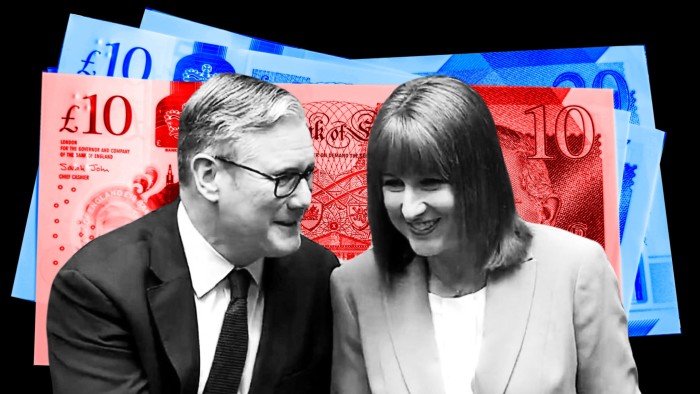Sir Keir Starmer did not call it a “relaunch” — but Labour officials admit that is what he meant.
“Today marks the end of the first phase of this government,” the prime minister told his cabinet, as ministers signed off chancellor Rachel Reeves’ spending review.
After a year dominated by tax rises, talk of fiscal “black holes”, welfare cuts and retreats over winter fuel payments, Starmer told ministers it was now time to move to a “new phase that delivers on the promise of change”.
It has taken 11 months since Labour was elected to get to this point, and privately some ministers wished Reeves had set out her spending priorities earlier. In the meantime Labour’s YouGov poll rating has slumped to 22 per cent, and Reeves’ own popularity has nosedived.
But by the time Reeves drew to the end of her House of Commons statement — setting out the government’s spending choices for the rest of the parliament — Labour MPs were shouting for “more”, the mood visibly lifting on the government benches.
For Reeves it was a crucial moment: she claimed she was rejecting Conservative “austerity” and showered borrowed money on infrastructure projects across the country, namechecking the Labour-supporting towns and cities that would benefit.
It was notable that Starmer cleared the political stage for what he plainly believed could be a moment of redemption for his chancellor. “Keir wanted this to be Rachel’s moment,” said one Labour figure. “She actually had some money to spend.”
Reeves’ allies believe the economics and politics of the spending review — which allocates cash across Whitehall for the next three or four years — will generate more growth and help secure a second term for Starmer’s government.
But there are clear problems ahead for Reeves, not least on questions of timing.
Not only has Labour’s first year in office been shrouded in economic gloom — possibly incurring lasting political damage — but her spending review could take many years to yield economic and political results.
Spending on day-to-day services — the kind that most people consume in their daily lives — will be limited to annual real terms increases of 1.2 per cent. It is a tight settlement that is hardly likely to transform services which are already creaking.
Reeves announced a 3 per cent real annual increase to the NHS England budget, but internal Department of Health modelling suggests it may not be enough to allow Starmer to hit his waiting list targets. It is also slower than historic real-terms growth rate of 3.6 per cent for the NHS.
The biggest part of Reeves’ speech was devoted to allocating £113bn of capital spending over the parliament. Labour towns from Port Talbot to Derby were namechecked by a chancellor keen to be seen to spread cash beyond London and the south-east.
Many economists believe that borrowing to invest in nuclear power stations, trans-Pennine rail connections, artificial intelligence and housing are the kind of thing a British government should be doing to boost the country’s growth potential.
But it could take many years for voters to feel the benefits. Reeves’ allies insist that voters have been pleased to learn about new tram and bus links in their cities, but they are unlikely to be buying tickets to ride on them any time soon.
By the time of the next election in 2029, many of these projects will not even be holes in the ground. Reeves is taking a long-term bet on the economy and “national renewal”, but will the voters be grateful?
In her statement, the chancellor was anxious to dispel the idea that she is an “austerity-lite” chancellor. Indeed, in her first Budget last year, Reeves set out a £70bn increase in overall annual spending during the parliament, funding by higher taxes and borrowing.
But because of the scale of the Department of Health — which is set to spend £202bn in the current fiscal year alone — Reeves’ 3 per cent annual uplift for the NHS forced her to impose a tough spending settlement on a host of other services.
Departments including housing and local government, culture, environment and business are all set to see real-terms cuts to their spending from 2025-26 to 2028-29.
Some of them are swingeing: the Foreign Office is set for a near-7 per cent real-terms squeeze over the spending review period, partly reflecting a cut in the overseas aid budget from 0.5 per cent of GDP to 0.3 per cent.
Defence was another big winner, with spending earmarked to rise to 2.6 per cent of GDP by 2027. But, as with many other facets of the spending review, this leaves major unanswered questions hanging over the government’s plans, analysts said.
In particular, with a Nato summit looming at the end of the month, the UK has not said how it will manage a transition to a 3 per cent of GDP defence budget — let alone one worth 3.5 per cent of GDP — if leaders agree to prioritise that kind of an uplift.
The government is meanwhile banking on making £1bn of annual savings on its asylum costs, although the both the previous Conservative government and Starmer’s administration have struggled to cut costs in that area, or to reduce boat crossings to the UK.
Overall departmental efficiency gains are meant to reach £14bn a year by 2028-29.
The plan also entails a frontloaded boost to spending, which tapers out during the parliament. While day-to-day real terms departmental spending is set to rise by 2.4 per cent in the current year, the growth rate will need to be driven down to 1.8 per cent in 2026-27 and then just 1 per cent in the subsequent years.
Successive UK governments have regularly pledged to clamp down on spending down the line, only to find the pressure for more investment in public services requires top-ups to departmental plans, putting further pressure on strained public finances.
The government’s recent record has fuelled investor scepticism — in particular because of Reeves’ U-turn on cuts to the winter fuel allowance and speculation that the government will further water down its welfare reforms.
Ruth Gregory at Capital Economics said the chancellor will probably be forced to top up spending later in the parliament given the frontloaded nature of the settlements laid out on Wednesday. “The tough decisions for the UK chancellor won’t end here,” she said.
Investors are widely expecting that tax increases on top of October’s £40bn rise will be necessary in the autumn Budget given poor growth, rising borrowing costs, and the continued upward pressure on Nato defence budgets.
“The public finances look to be in a worse state than in March, so she has to come back and resolve that in the future,” said Andrew Goodwin at Oxford Economics. “It suggests tax rises in the Budget.”
But for Starmer, addressing cabinet ministers on Wednesday on the final contours of the spending review, this was a decisive moment as he and Reeves try to shift the political and economic debate. “The message was simple,” said one person in the room. “Let’s go and sell it.”








